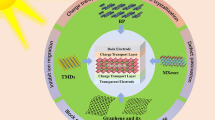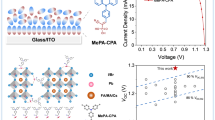Abstract
Lead-free bismuth oxyiodide (BiOI) perovskite solar cells (PSCs) have been successfully fabricated using successive ionic layer adsorption and reaction technique. The effect of heat treatment temperature on thickness, conductivity and microstructure of BiOI thin films has been studied prior to the device fabrication. The BiOI film morphology formed flake agglomeration like flower platelets for as deposited BiOI film. However, the agglomeration and the flakes were shattered when the BiOI was annealed above 450°C. This is associated with the trend in conductivity measurement where BiOI achieved the optimum conductivity when it was heat treated at 350°C and reduced as the heat treatment exceeded 450°C. This could be due to the reduction of grain boundaries because of development of the flake sizes during the heat treatment, material sublimation and particle aggregations that developed higher resistance in the BiOI layers. The device performance under optimum heat treatment has been characterized using I–V measurement under a solar spectrum simulator with AM 1.5 illuminations. BiOI PSCs treated at 350°C showed ~ 6% efficiency. This study provided better understanding on BiOI thin film behaviors under several heat treatments, and it has potential to be applied as lead-free PSCs.




Similar content being viewed by others
References
J.P. Correa-Baena, M. Saliba, T. Buonassisi, M. Grätzel, A. Abate, W. Tress, and A. Hagfeldt, Science 358(6364), 739 (2007).
P. Su, Y. Liu, J. Zhang, C. Chen, B. Yang, C. Zhang, and X. Zhao, J. Phys. Chem. Lett. 11, 8 (2020).
F. Alharbi, J.D. Bass, A. Salhi, A. Alyamani, H.C. Kim, and R.D. Miller, Renew. Energy 36(10), 2753 (2011).
A. Kariper, Mater. Res. 19, 1 (2016).
J. Di, J. Xia, H. Li, S. Guo, and S. Dai, Nano Energy 41, 172 (2017).
A. Abuelwafa, R.M.D. Matiur, A.A. Putri, and T. Soga, Opt. Mater. 109, 110413 (2020).
A.A. Putri, S. Kato, N. Kishi, and T. Soga, Appl. Sci. 9, 3342 (2019).
N.A. Abdul-Manaf, A.H. Azmi, F. Fauzi, and N.S. Mohamed, Mater. Res. Express 8, 096401 (2010).
H.S. Kim, A. Hagfeldt, and N.G. Park, Chem. Commun. 55(9), 1192 (2019).
R.L. Hoye, L.C. Lee, R.C. Kurchin, T.N. Huq, K.H. Zhang, and J.L. MacManus-Driscoll, Adv. Mater. 29(36), 1702176 (2017).
Y. Kumar, E. Regalado-Pérez, A.M. Ayala, N.R. Mathews, and X. Mathew, Solar Energy Mater. Solar Cells 157, 10 (2016).
Acknowledgements
The authors would like to thank Ministry of Higher Education for the Fundamental Research Grant Scheme (FRGS) FRGS/1/2019/STG07/UPNM/02/3.
Author information
Authors and Affiliations
Corresponding author
Ethics declarations
Conflict of interest
On behalf of all authors, the corresponding author states that there is no conflict of interest.
Additional information
Publisher's Note
Springer Nature remains neutral with regard to jurisdictional claims in published maps and institutional affiliations.
Rights and permissions
Springer Nature or its licensor (e.g. a society or other partner) holds exclusive rights to this article under a publishing agreement with the author(s) or other rightsholder(s); author self-archiving of the accepted manuscript version of this article is solely governed by the terms of such publishing agreement and applicable law.
About this article
Cite this article
Manaf, N.A.A., Azmi, A.H., Amat, A. et al. The Effect of Heat Treatment on Bismuth Oxyiodide Thin Films for Lead-Free Perovskite Solar Cells. JOM 75, 754–758 (2023). https://doi.org/10.1007/s11837-022-05660-y
Received:
Accepted:
Published:
Issue Date:
DOI: https://doi.org/10.1007/s11837-022-05660-y




